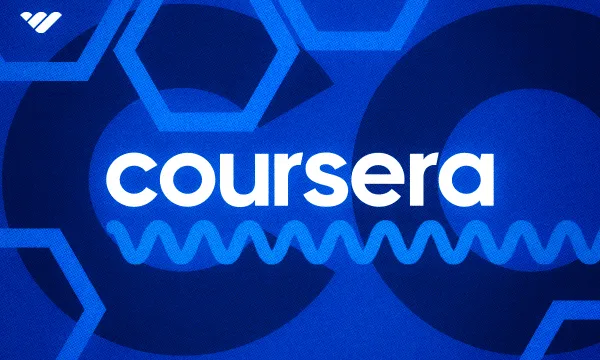Selling courses online can be incredibly profitable – and the demand for online courses is only expected to grow. By 2029, forecasts predict that consumers in the online learning market will exceed 1.1 billion.
If you want to get started in this sector, finding the best course platform is one of the most important choices you will make, with the right decision having a big impact on your potential earnings.
There are plenty of platforms available for you to host and sell courses. Each comes with different tools and features that can benefit you as a course instructor. But how can you know which platform is the best for your online course content?
Whop has got you covered. Read on as we review ten of the most popular online course platforms. Here are the pros and cons of each, with commission rates, to help you find the one that’s best for you. But first, let's look at how to find the right platform for your course.
Don't have time to read through the full list? Jump ahead to the comparison table of the best online course platforms.
How to Choose the Right Course Platform for You
First things first, you’ll want to know what you’re looking for in a platform. It’s important to consider the specifics of your situation as a course creator. Below, we’ll look at some factors when choosing the right platform for your needs.
Subject matter
There’s no use publishing an online course onto a platform if it’s not a good fit. Remember, the main benefit of choosing a platform is the number of students you can reach.
Let’s say you want to publish courses on creative writing. In this case, a platform like Skillshare is a good option, as there are already many users looking for courses that teach this skill. Carefully consider the field of your course and make sure you select a platform that matches.
Growth
If you want room to grow, this is something you should decide on before you commit to a platform. Some platforms have room for infinite scaling, whereas others might be more limited depending on your goals.
You should outline future goals for your courses before selecting a platform. For example, if you’re searching for a platform that not only lets you sell course but also helps course creators sell their content, ebooks, and create an online community, try Whop.
Budget
Budget is another key thing to keep in mind. Our list of online course platforms includes a range of price plans, with some requiring monthly or annual subscriptions. If you have a large budget, then you could go for one of the more expansive platforms without worrying (but just because you could doesn't mean you should).
If your budget is limited, or if you want to keep as much of your revenue as possible, it is best to opt for a platform that only charges transaction fees without the need for additional subscriptions. Remember, many platforms come with a free trial or version that you can use to figure out if they’re right for you before committing to a purchase.
Control
This is another important factor to consider. Platforms like Whop, Thinkific and Kajabi will give you total control, while other platforms such as Udemy and Skillshare have stricter rules around what a course should look like.
Decide whether you want flexibility and learn more about how much room-specific platforms offer you in terms of content.
Support
If you’re a first-time creator, then having community support is vital for your success. Some online course platforms offer a range of community support, from networks where you can ask questions to tutorials, troubleshooting pages and weekly support to help expand your business. Features like this can be especially helpful for new or inexperienced creators.
You should also consider general customer support. There’s nothing worse than having your course go down just as it’s getting some attention. Platforms like Whop and Kajabi have excellent customer support making them ideal for creators who need assistance.
Platform types
Finally, there are some different types of platforms to consider:
- Standalone platforms – Specializing in one element of course creation or selling, such as hosting or content creation.
- All-in-one platforms – Offering everything you need to create, host, and sell your courses without needing other tools.
- Marketplaces – A place to easily host and sell courses but with lots of competition and less control.
The Best Online Course Platforms: Pros, Cons, and Features
1. 🏆Whop
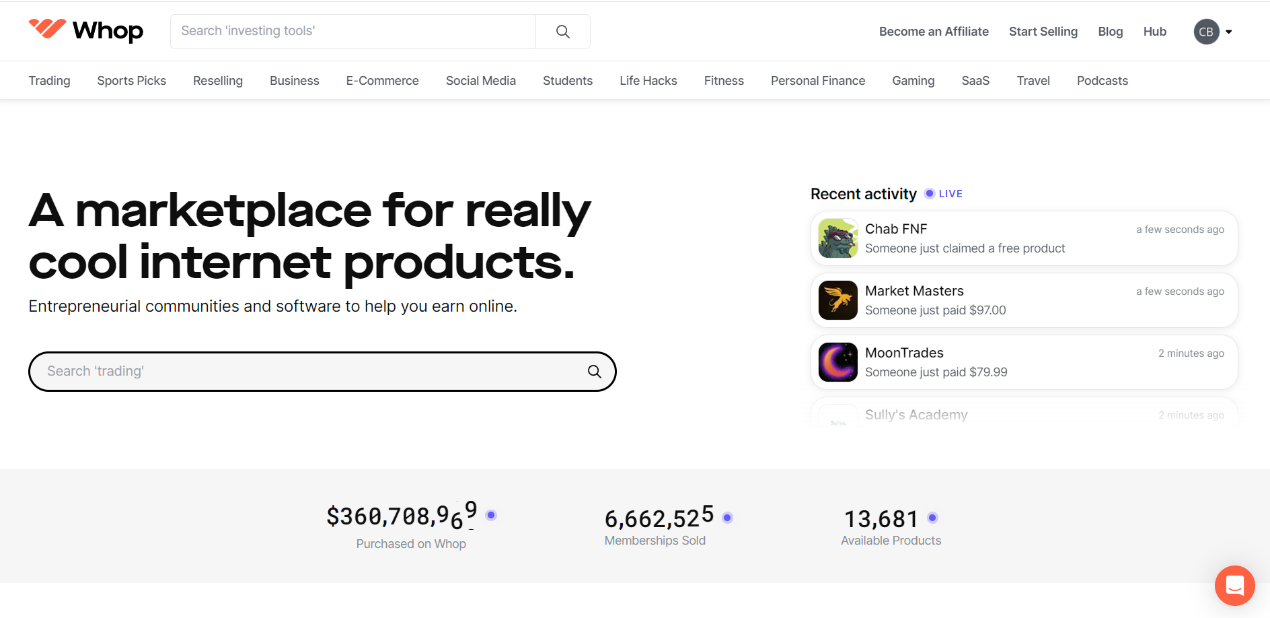
We kick off this list with the best of the best. While there are many popular platforms out there to choose from, it can be difficult to find one that covers all bases. Confusing subscription tiers, locked features, and specialized platforms mean that you can feel left out as a course creator who wants everything with room to grow.
If you’re looking for a simple, flexible, and scalable way to sell digital products online, including courses, Whop is the platform for you. Whop is a social commerce platform that helps course creators sell their content and create memberships. You can manage everything – community access, eBooks, downloads, and courses – as part of a subscription model or a simple one-off fee.
If community building is your focus, Whop allows you to sell Telegram or Discord group memberships, meaning your students won’t have to move to a platform they don’t already use. Or, you can create your own community directly in your whop and keep your members in one place.
Whop also cuts out any frustrating subscription tiers or scaling transaction fees, charging a small 3% flat fee on each sale that you make. This means you can sign up and try out a new product without having to commit to a big financial risk.
Who is Whop best for?
Whop is for every type of creator. Whether you are selling sports picks, art tutorials, reselling courses, real estate knowledge or anything in-between, you can make a course and sell it on Whop. With guided course creation, the ability to create a community around your course, and the freedom to add as many or few complementary experiences as you like, Whop is for everyone.
How do creators get paid on Whop?
Creators who direct their customers to their own whop keep 97% of their earnings. Payments are processed through Stripe via ACH and delivered in the currency that your customers pay in.
Whop Pros & Cons
Pros:
- Ability to create a community for your course.
- Can sell multiple complementary digital products from the same whop.
- Can offer customers a variety of payment options, including crypto and BNPL.
- 24/7 customer service.
- Industry-leading low fees.
- Simple set up.
Cons:
- Does not yet have the same reputation as other big-name course platforms.
2. Udemy

Udemy has rapidly become one of the most popular online course hosting platforms. With a base of over 65 million students enrolled and an instructor base of 75,000 people, this is likely one of the first platforms you’ll find when searching online.
Udemy sorts its catalog into a series of top categories. You’ll find courses in Design, Development, Marketing, IT, Software, Personal Development, Business, Photography, Music and more.
So how does Udemy work for an instructor? The first hurdle is applying. This process isn’t too extensive but does require you to show that you have the skills needed to design an effective course. You will then be allowed to use the platform to design and produce your course. Each course requires 30 minutes of video, split into five lectures.
One of the best things about Udemy is how effectively you can market a course on the platform. With such a broad user base, you’ll be able to find students and grow your courses with ease. Udemy lets you join marketing programs that help spread the word about your courses, including discount schemes, email lists, and affiliate marketing programs.
Who is Udemy best for?
Udemy is ideal for creators who want to reach new demographics with their courses. Their large user base, simple tools and guided course creation also help new teachers to get started. It should be noted that it might not be the best choice for new teachers looking to get a large pool of students right away, as it is a competitive platform with a lot of different courses for students to choose from. If this has out you off, try these Udemy alternatives instead.
How do creators get paid on Udemy?
Premium instructors on Udemy become part of the platform’s revenue-sharing plan. Instructors get 37% of revenue for any sales occurring on the site. If a student purchases their content using an instructor’s coupon or referral link, then the instructor will receive 97% of the revenue.
Udemy pros & cons
Pros:
- Guided course creation.
- Large userbase makes it easy to find students.
- Simple setup without personalization.
Cons:
- Udemy takes a 50% commission on all regular course sales, which is much steeper than other platforms.
- Competitive platform with a lot of other instructors.
- Useful features like the Udemy Marketplace Promotion Plan will lock your courses into specific price points.
3. Skillshare
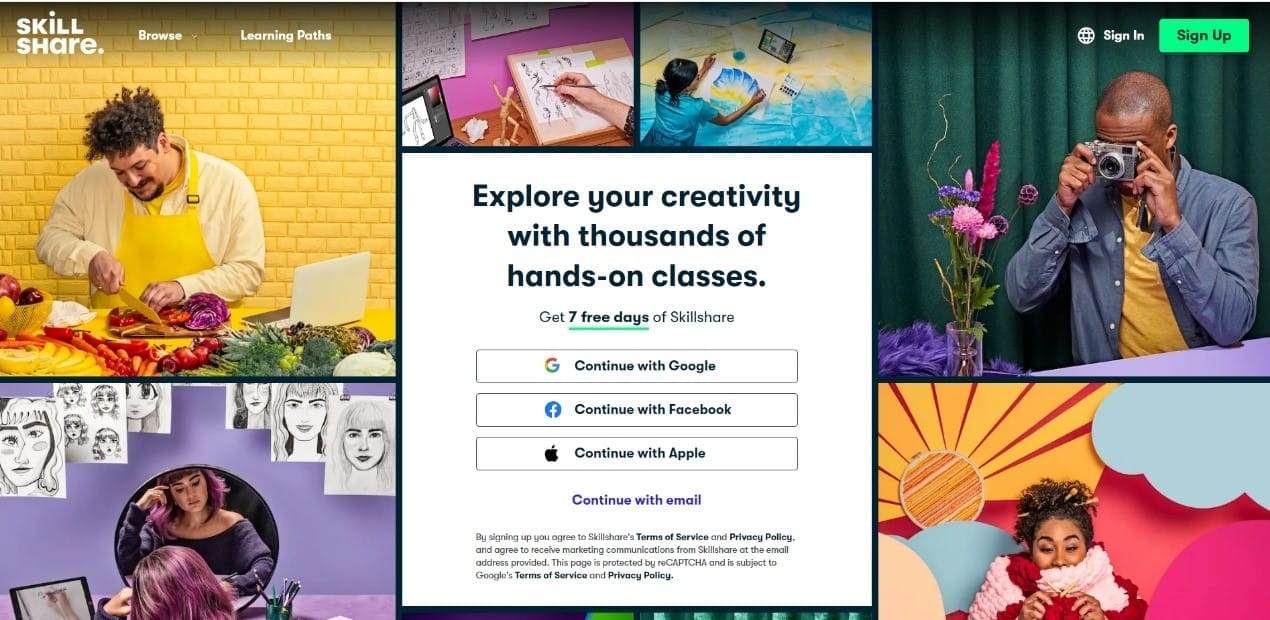
Another of the most popular online course platforms on the internet is Skillshare. Skillshare focuses on creative disciplines, encouraging teachers to create engaging courses and share them with students of all abilities. Some examples of courses you’ll find on Skillshare include creative writing, photography, painting, game design, and cooking.
Skillshare works slightly differently from Udemy and Whop, offering students a simple membership option that gives them access to a huge library of courses. If you want to become a teacher on Skillshare, you’ll need to submit an application to be reviewed by the Skillshare team. In the application, you should outline what your first course will look like to give them an understanding of the type of content you wish to upload.
Who is Skillshare best for?
Skillshare is one of the best online platforms for small creatives. If you have a niche creative skill, with a lot of unique knowledge to impart, Skillshare is a great choice.
The simplicity of Skillshare is also incredible for first-timers looking to begin their online teaching journey. But, if you’re already an established teacher, you might find some of Skillshare’s features lacking compared to other platforms.
How do creators get paid on Skillshare?
Skillshare pays teachers based on two key metrics – minutes watched and engagement. You are then awarded a slice of the monthly earnings depending on how well your course has been received. This is both a positive and a negative for teachers on the platform, as you will need to get a lot of engagement before you earn good money.
Skillshare pros and cons
Pros:
- Large audience base. With over 12 million registered students, Skillshare gives you a lot of exposure.
- Skillshare focuses on the instructor, which is great for building a personal brand.
- You can create short videos, meaning you won’t have to commit to huge hour-long lectures in your course.
Cons:
- Tough growth for beginners.
- Income depends on views & engagement and is confusing to understand.
- Not suitable for more academic topics.
4. Teachable
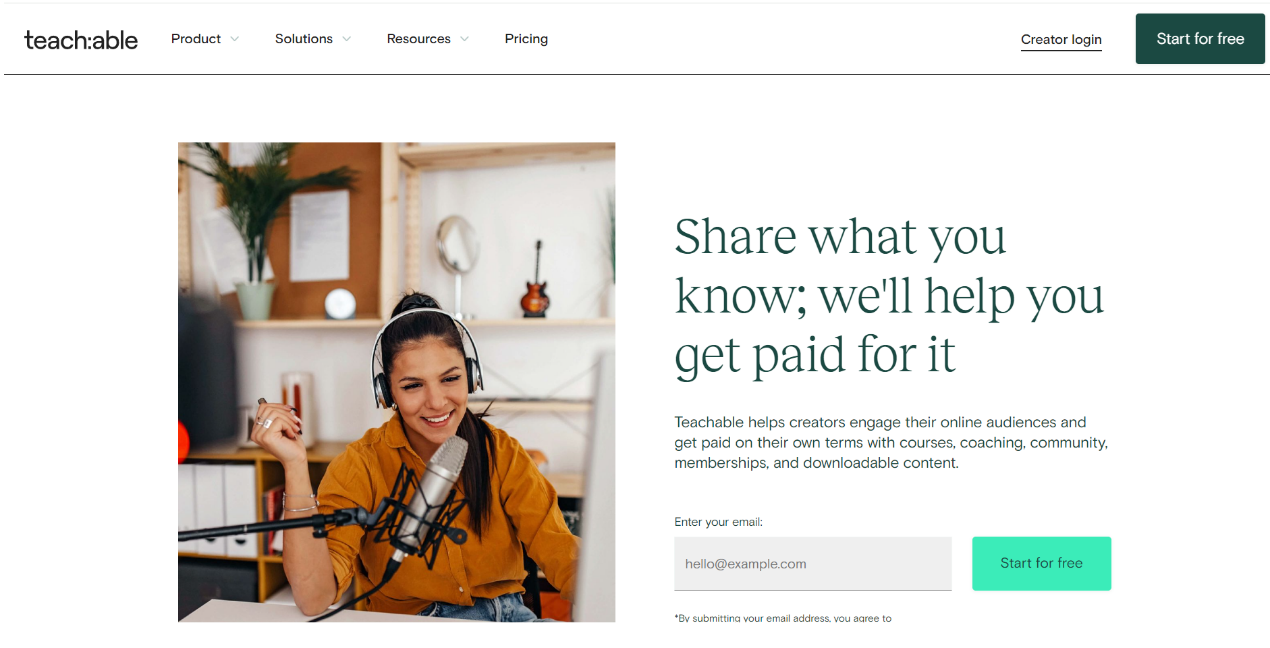
Teachable is another online learning platform that allows instructors to create a range of online courses and schools. With an emphasis on giving control to teachers, especially when creating communities and engaging with their online audience, teachable is a strong choice for coaches and entrepreneurs.
Teachable gives you a range of tools to help you begin your online career. You outline your content – whether that’s a coaching program, a digital product, or a course for students to enrol in. After that, you set a price and manage it through their user-friendly sales page builder. The final step is to upload your content with their simple drag-and-drop builder, which allows you to create everything from videos and slides to quizzes and more.
Who is Teachable best for?
Teachable shines as a platform for coaches, creative professionals and people who are new to creating online courses. It features one of the easiest-to-use course builders out there and gives you a lot of control from the jump. This makes it a great choice for anyone looking to get started and connect with their students.
How do creators get paid on teachable?
One of Teachable’s main selling points is how it offers a range of monetization tools. You can add upsells, bundles, or order bumps on any given product or program. Teachable’s Pay program also offers you automated tax filings, fraud monitoring, chargeback support and e-commerce optimization tools.
This means you can customize your experience, finding payment channels that best suit your business.
But what about transaction fees? Teachable has a sliding scale depending on the plan you have chosen. For free users, each transaction costs $1 plus 10% of the transaction. For basic users, it’s a flat 5% fee. For pro, pro+, and business users, you will enjoy a 0% transaction fee.
Keep in mind there are additional processing fees that may occur. For a complete list, check their plans and fees page.
Teachable pros and cons
Pros:
- Features simple course-building tools to make it easy for first-timers.
- You can add a range of course content including quizzes and certificates.
- Additional payment tools and support.
- Stellar customer support.
Cons:
- Email marketing features are poor compared to other platforms.
- Expensive transaction fees for ‘free’ and ‘basic’ plans.
- You may need to invest in additional tools to get the most out of Teachable.
5. Thinkific
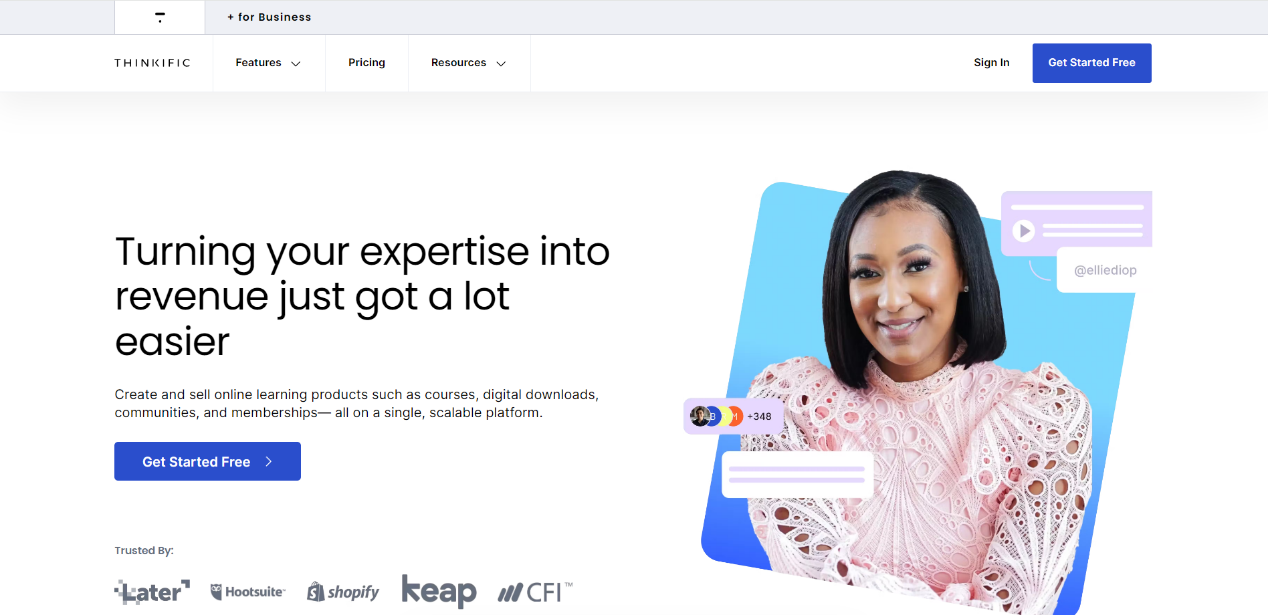
Thinkific was launched in 2012 with the aim of becoming a versatile platform where educators can sell customized courses. Quickly establishing itself as a key player in the e-learning industry, many creators choose it as their platform of choice due to its wide range of tools and features.
A central part of Thinkific’s design is simplicity. Creating courses has been made easy with a user-friendly interface that allows teachers to design and arrange their content – whether they want to add video lessons, assignments, downloadable resources or additional content like quizzes. Thinkific also comes with a range of marketing tools, with highlights including custom landing pages, sales tracking and marketing integration.
Who is Thinkific best for?
Thinkific is bets for creators who want a multi-media experience where they can sell more than just courses.
How do creators get paid on Thinkific?
Like many other online course platforms, Thinkific offers a scaling price system. You can choose from the following versions:
- Free
- Basic - $36 per month
- Start - $76 per month
- Grow - $149 per month
- Thinkific Plus - custom
Each plan offers you more features, including additional course slots, communities, digital downloads, student caps and customer support. Plans provide a 0% transaction fee, but you can choose to use Thinkific Payments as an alternative to other payment processing options.
You might be thinking – what’s the catch? How can each of these plans (even the free version) offer 0% transaction fees when other platforms usually charge? The answer is that plans scale depending on the size of your online course content.
Keep in mind the subscription prices for Thinkific are more expensive than average – this is the main reason for the 0% transaction fee. Depending on what you’re looking for, this could be benefit, especially if you are looking to publish one course without commitment.
Thinkific pros and cons
Pros:
- Features a simple course builder that requires no prior knowledge of designing courses.
- Thinkific is a platform that offers a huge list of tools, from creating a course to building an online community.
- Thinkific also has one of the best support networks out of all the platforms on this list.
- No commission, though you could argue transaction fees are baked into their many subscription tiers.
Cons:
- The subscription tiers of Thinkific can be confusing and vastly expensive. It’s important you pick the right tier for your needs, or else you may find yourself without features/course slots.
- Thinkific Marketplace is a feature that helps to connect you with developers who can help you create apps specifically for your courses. This is a nice feature, but the price of these apps is high.
6. Coursera

One of the most popular online course platforms around is Coursera. With a user base of 100 million, Coursera is one of the premier choices for academic courses and certificates. While some of the other courses we have looked at so far focus on creative disciplines, Coursera is directly aimed at teachers with authority in their field.
Coursera was launched to revolutionize online learning, providing users access to high-quality courses and even degrees from universities and organizations worldwide. It partners with leading institutions including Standford, Yale, Google and IBM. Coursera doesn’t abandon the idea of giving course creators agency, but it has higher requirements for its courses when compared to other online learning platforms.
So, what does this mean for those who want to sell their online courses on Coursera? In short, the selection process for instructors is much steeper than other platforms. To be accepted as an instructor, you’ll need to be a professor or have authority in your field.
Who is Coursera best for?
Coursera is best for established professionals backed by institutions. It is not the type of platform you can publish courses on if you don’t have these accolades. However, if you are an industry leader or academic, it is one of the best choices to publish courses and offer them to a huge base of potential students.
How do creators get paid on Coursera?
Payment models on Coursera are slightly different, due to the presence of accredited universities or educational institutions. These will generally partner with Coursera and can be paid through wider systems such as Coursera’s Revenue Sharing Model, or payments to the institutions, who then pay their instructors. Keep in mind that some courses may also be funded by grants, allowing instructors to receive additional compensation through them.
Coursera pros and cons
Pros:
- Publishing a course on Coursera exposes you to a pool of 100 million students.
- Every course on Coursera is heavily vetted and high quality.
- Perfect for industry professionals, businesses, or academic institutions who want to publish courses online.
Cons:
- High barrier to entry – you won’t be able to teach on Coursera without some impressive credentials.
- Most of Coursera’s courses are linked to universities or large educational institutions. This can make payment for instructors complicated.
7. Kajabi
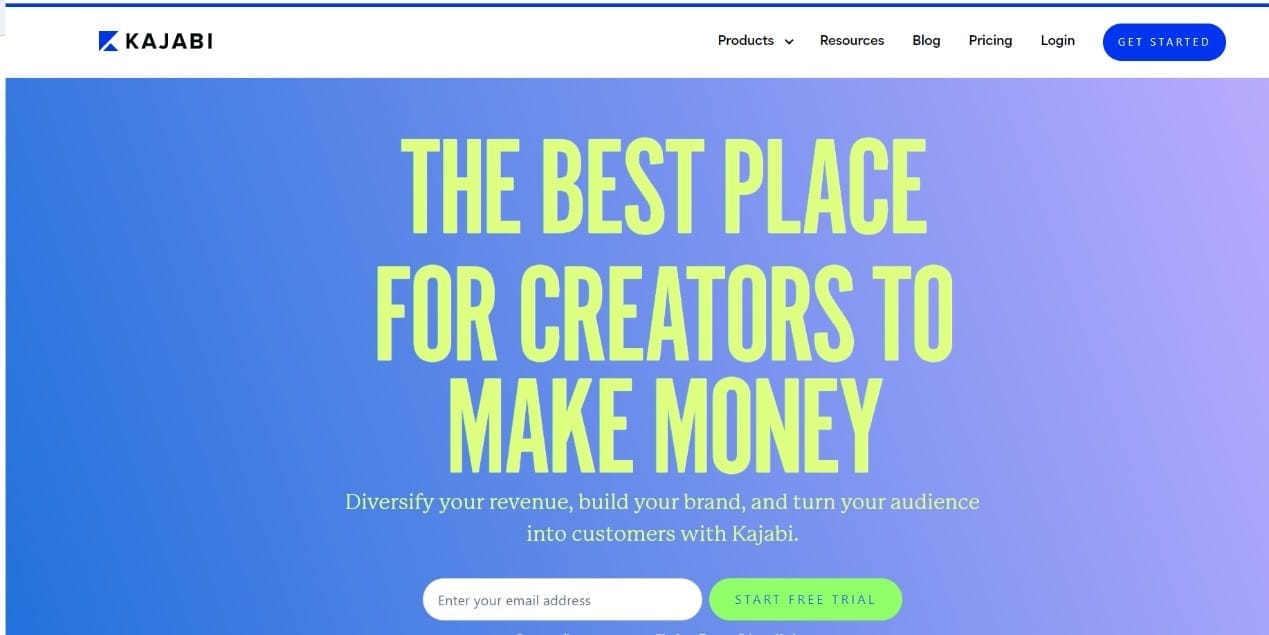
Kajabi is an all-in-one online platform that lets you sell a range of digital products including coaching programs, memberships and courses, all from one location. Kajabi focuses on a large toolbox of features that empower entrepreneurs, educators and businesses to create and market their digital content.
Kajabi’s all-in-one design means that it offers a lot of flexibility for creators. The platform supports many different types of content including videos, podcasts and extensive written material. Many of these features are standard for online course platforms, but Kajabi stands out considering its wider range of useful tools.
By integrating websites, course design, membership sites and email marketing into one platform, users can eliminate the need for multiple subscriptions and third-party tools.
Who is Kajabi best for?
Kajabi is a good choice for anyone who wants everything covered. Perhaps you’re a small creator looking to upload your first course, but still want room to scale. Kajabi gives you the tools to do so.
If you’re already an established creator, then Kajabi offers many of the tools you need to enhance student experience and effectively market your courses. In short, Kajabi is a platform that caters to a broad range of course creators.
How do creators get paid on Kajabi?
Like Thinkific, Kajabi uses a subscription tier model that lets you fit your budget with the scale of your business. There’s no free version, but they do offer a 14-day trial to help you get started. The subscription tiers include:
- Kickstarter - $55 per month
- Basic - $119 per month
- Growth - $159 per month
- Pro - $319 per month
- Enterprise – custom
None of these plans require you to pay transaction fees for what you sell on the platform, meaning you won’t have to pay any commission. The price you set for your courses is what you will make.
Kajabi pros and cons
Pros:
- Kajabi is an all-in-one platform, eliminating the need for additional subscriptions.
- With a range of sales and marketing features, you can manage every aspect of your business.
- Kajabi helps you connect with your audience through membership sites and interactive features.
Cons:
- Kajabi has lots of different subscription tiers and you will have to pay for the higher tiers if you want your courses to scale.
- Kajabi is one of the more complicated platforms to use, especially for new teachers.
- There’s no transaction fee, but the general cost of subscription tiers is higher than other platforms.
8. LearnDash
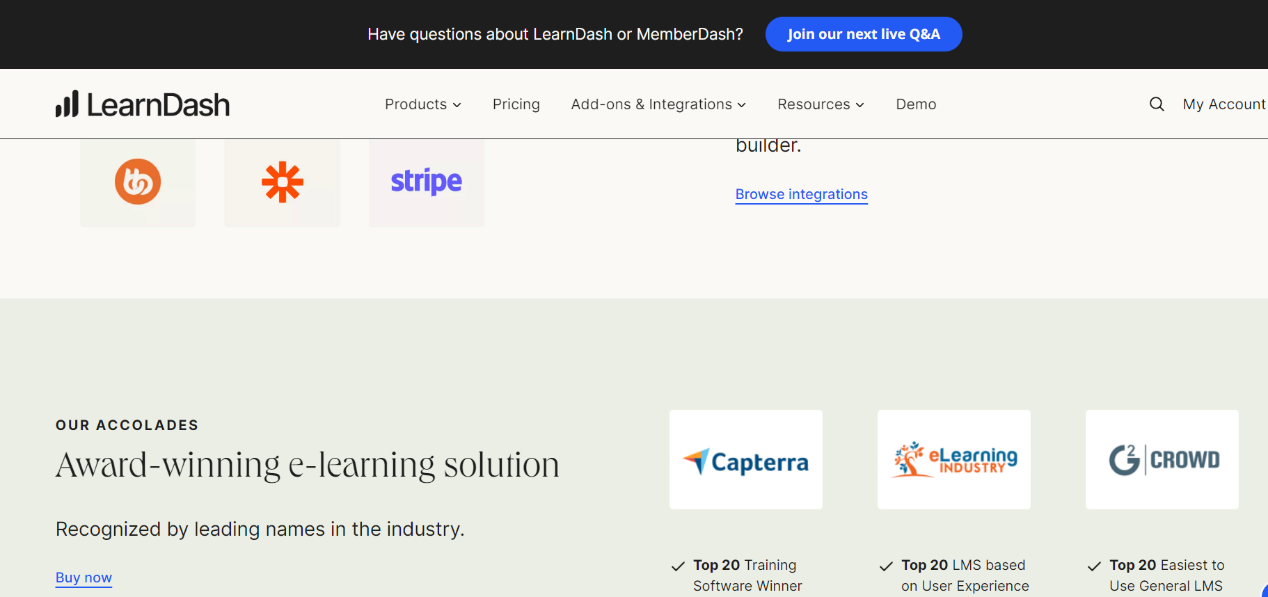
LearnDash is different from the other platforms on this list because it is a WordPress LMS plugin. This means it is a piece of software you can add to your WordPress website, allowing you to design, manage, sell and promote your online courses.
After purchasing LearnDash, you will find it at the top of your WordPress website dashboard, offering you a series of tools to help you create courses. If you’re worried about LearnDash breaking other parts of your site when you add it – you can rest easy! LearnDash is designed to connect with the addons and tools you already use on your website. It’s also compatible with all WordPress themes and page builders.
Who is LearnDash best for?
We’ll begin with the obvious – LearnDash is only worth getting if your website has been created with WordPress. It’s a handy tool for anyone who wants to add online courses to their website.
Perhaps you already have a brand and want to branch out into course creation to share the knowledge you’ve learned and engage your audience. If you’re already using WordPress, then this is a simple way to begin your teaching journey.
How do creators get paid on LearnDash?
One of the most appealing aspects of LearnDash is how unintrusive it is when it comes to revenue. LearnDash is dedicated to never taking a cut of your earnings, meaning you will keep everything you earn from your courses.
LearnDash pros and cons
Pros:
- A simple plugin for a WordPress site, meaning you won’t have to commit to an entire platform.
- Integrates with existing website content, add-ons and tools.
- No commission or transaction fees, allowing you to stay in control of your course revenue.
Cons:
- LearnDash can be fiddly to set up, especially if you’re new to WordPress or online course creation. There are many settings you may need to tweak before it works the way you want it to.
- It requires a WordPress website.
- You may need additional plugins for your website which can be time-consuming.
9. Mighty Networks

This is one of the lesser-known online platforms on this list, but a great choice if you’re looking to create strong communities through your courses. Mighty Networks is a platform that helps you build active paid communities around your courses. With a host of tools, you can manage everything from creating communities, paid groups, events and extensive courses.
With Mighty Networks, you can sell individual courses or community memberships – and they have the option to create bundles. You can set a range of prices for your memberships or sell courses separately.
One of the best features of Mighty Networks is its Activity Feed. This is a tool that comes with each course you build on the platform, letting you see your engagement and allowing you to quickly communicate with members. This isn’t just for you – it’s for your members too. They can share content from images, links and comments. This allows you as the course leader to constantly connect with your audience and help build a sense of community.
Who is Mighty Networks best for?
Mighty Networks excels as a platform for people looking to build a community. It requires some additional work but gives you all the tools you need to engage. This works well for small creators, or larger brands – depending on the type of community they want to create.
How do creators get paid on Mighty Networks?
Here’s the main downside for Mighty Networks – it’s pricey! The platform operates on a tiered subscription basis, with the following tiers available:
- Courses - $99 per month
- Business – $179 per month
- Path-to-Pro - $360 per month
- Mighty Pro – enquire for details
Unfortunately, this isn’t the end of the costs when you look at revenue. Mighty Networks also charges transaction fees on top of this subscription. For the lower tiers (Courses and Business) there is a 2% transaction fee, with slightly lower costs on higher tiers.
Mighty Networks pros and cons
Pros:
- One of the best places to create online communities.
- Bundle memberships and courses together with a range of customization options.
- The Activity Feed lets you instantly connect with your students.
Cons:
- Subscription prices on top of transaction fees may be off-putting for smaller-scale course creators.
- Not suitable for creators who want to publish a single course.
10. Podia
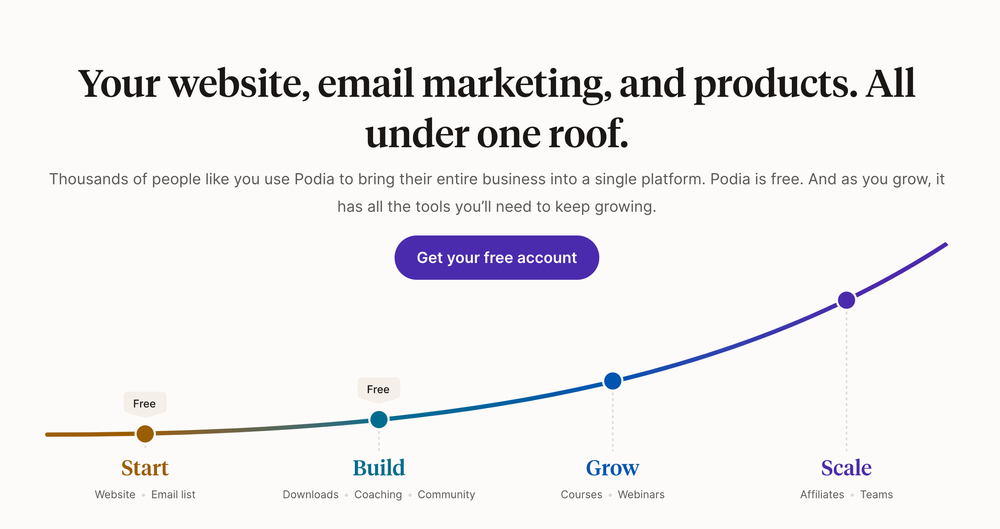
Podia is another smaller platform for course creators, and it is one that focuses on courses, coaching, and community management. It does not have an online marketplace but is a white-label option for creating and delivering courses.
Podia has a built-in course builder, where courses are divided into lessons and sections. Creators can edit these using a drag and drop tool and also add text, embed media, set up quizzes and share files. There are options for content dripping and course certificates.
Who is Podia best for?
Podia is designed for educators and coaches, and so it supports a small range of products. However, the platform does have white-label options, making it a good option for creators who want to deliver a branded course experience. Creators can customize product pages, courses, and sales pages, in addition to language, site structure, and fonts.
How do creators get paid on Podia?
Podia also offers a tiered subscription service, and the options are as follows:
- Free - $0 per month, but a hefty 10% fee
- Starter – $9 per month and an 8% fee
- Mover - $39 per month and a 5% fee
- Shaker – $89 per month and no fees
With Podia, certain features are paywalled behind subscription tiers. For example, the free tier only allows creators to offer one download product and one coaching product. The Starter tier offers this plus chat support and a custom domain.
It isn't until the Mover tier that you have the ability to create courses, webinars, and unlimited downloads. To access marketing features, you have to pay for the Shaker tier.
Podia pros and cons
Pros:
- White-label websites.
- Choice of payment processors.
- Sophisticated course creation.
Cons:
- Features locked behind paywalls.
- Limited range of products.
- 10% fees on the free plan.
Best Online Course Platforms Compared
Here's a table summarizing the features and pricing of the online course platforms mentioned:
| Platform | Features | Pricing | Pros | Cons |
|---|---|---|---|---|
| Whop | Community building, multiple digital products, various payment options, 24/7 customer service | 3% flat fee per sale | Create a community, sell various products, low fees, simple setup | Less known compared to other platforms |
| Udemy | Guided course creation, large user base, marketing programs | 50% commission on regular sales, 37% revenue share, 97% for coupon/referral sales | Easy to find students, simple setup, large audience | High commission fees, competitive, price locks with Marketplace Promotion Plan |
| Skillshare | Creative focus, membership access, application review for teachers | Based on views and engagement, part of monthly earnings | Large audience, good for personal branding, short video courses | Tough for beginners, income depends on engagement, not suitable for academic topics |
| Teachable | Easy-to-use course builder, quizzes, certificates, payment tools | Free: $1 + 10% per transaction; Basic: 5% per transaction; Pro/Pro+/Business: 0% per transaction | Simple course building, various content options, additional payment support, strong customer support | Poor email marketing features, high transaction fees for free/basic plans, may need additional tools |
| Thinkific | Simple course builder, marketing tools, custom landing pages, sales tracking | Free; Basic: $36/month; Start: $76/month; Grow: $149/month; Plus: Custom | User-friendly, wide range of tools, good support network, no transaction fees | Expensive subscription tiers, confusing pricing, expensive app development |
| Coursera | High-quality academic courses, partnerships with universities, degrees, steep instructor requirements | Revenue sharing model, payments via institutions, additional compensation through grants | Access to 100M students, high-quality courses, suitable for industry professionals and academics | High barrier to entry, complex payment system, primarily for established professionals |
| Kajabi | All-in-one platform, flexible content types, sales and marketing integration | Kickstarter: $55/month; Basic: $119/month; Growth: $159/month; Pro: $319/month; Enterprise: Custom | Comprehensive toolset, integrates websites and email marketing, interactive features for audience engagement | High subscription costs, complex for new users, higher overall cost despite no transaction fees |
| LearnDash | WordPress LMS plugin, integrates with existing site tools, no commission fees | Standard: $199/year; Plus: $329/year; Pro: $499/year | Easy integration with WordPress, no transaction fees, compatible with existing content | Requires WordPress, can be fiddly to set up, may need additional plugins |
| Mighty Networks | Community building, activity feed, paid memberships and courses, events | Courses: $99/month; Business: $179/month; Path-to-Pro: $360/month; Pro: Custom | Strong community tools, customizable bundles, real-time engagement through activity feed | High subscription and transaction fees, not suitable for single course creators |
| Podia | Courses, coaching, community management, white-label options | Free: 10% fee; Starter: $9/month + 8% fee; Mover: $39/month + 5% fee; Shaker: $89/month + no fees | White-label, flexible payment processors, sophisticated course creation | Paywalled features, limited product range, high fees on free plan |
Creating and Selling Courses With Whop
Creating a course on Whop is simple, but the best part is that your online business doesn't have to end with courses. Whop allows you to market your product in any way you see fit, taking control of your brand and offering content to your students in a way that best reflects your goals. From selling digital products alongside your course, to offering a community chat, check-in webinars, giveaways, and a whole host of other features, you can do it all in one place with Whop.
If you’re a course creator searching for the best platform for your online content, join Whop today and get started for free.


